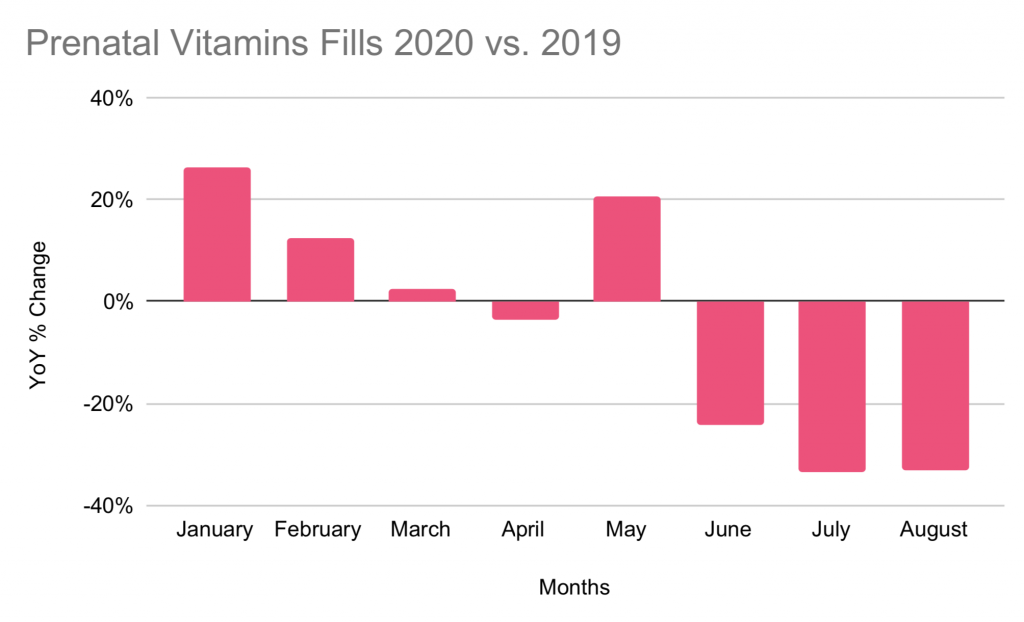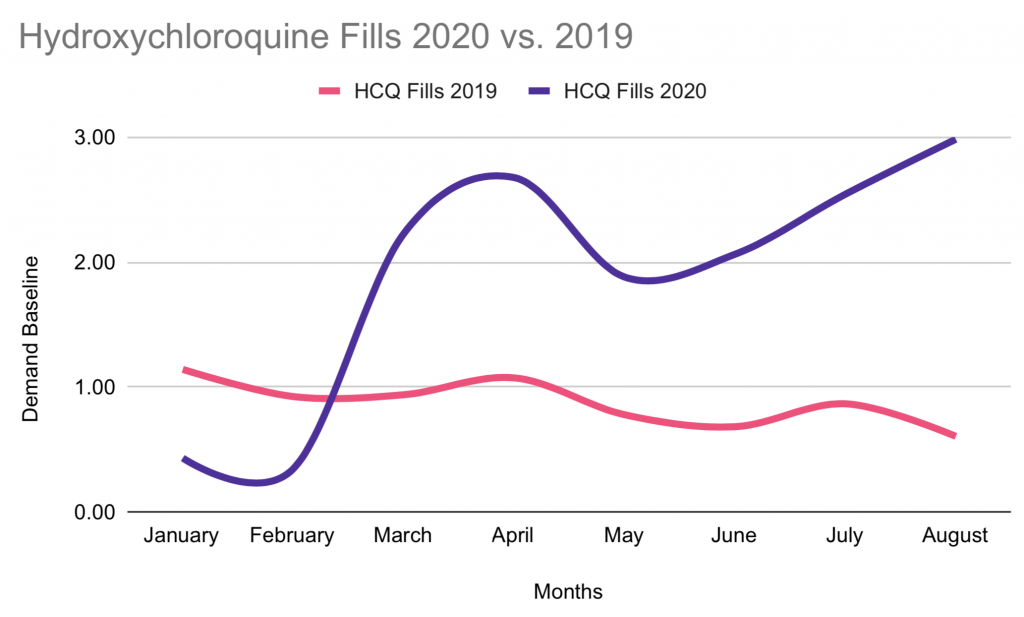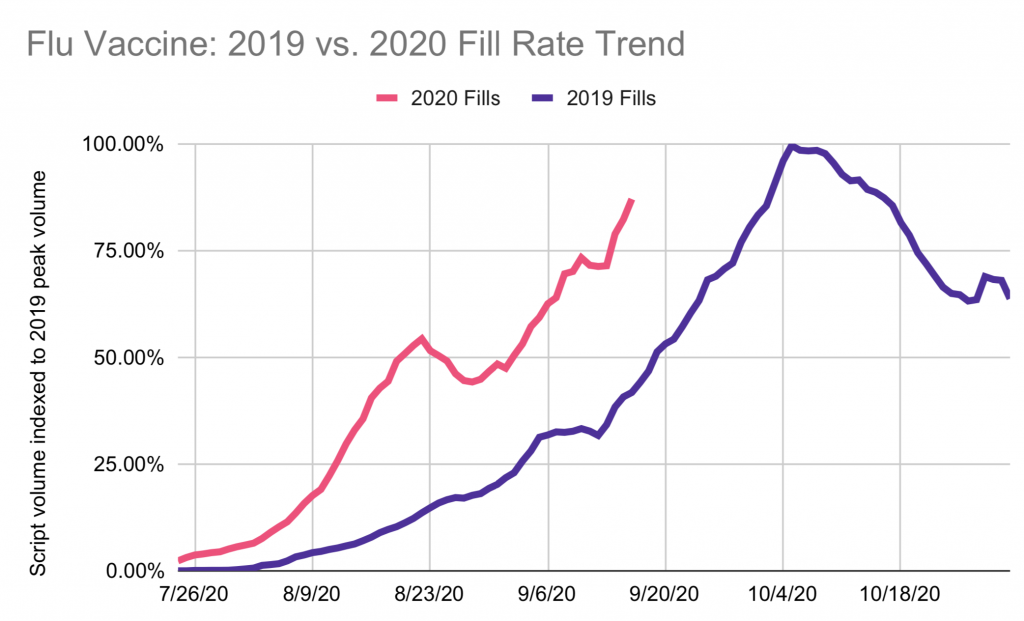The coronavirus pandemic has changed the behavior of millions of Americans in many ways, including what’s inside their medicine cabinets. At the beginning of March, pharmacies across the U.S. saw prescription supply shortages, and common over-the-counter medicines were often out of stock as many stockpiled to prepare for shelter-in-place orders. As states began to reopen in May, new consumer trends and behaviors emerged.
SingleCare analyzed year-over-year prescription fill data trends of thousands of drugs across 35,000 pharmacies nationwide to see what’s changed inside the U.S. consumer’s medicine cabinet since the onset of the pandemic.
Prenatal vitamin fills decrease point to a potential baby bust in 2021
As the country shut down in March and April, many speculated that there might be a baby boom as a result of couples quarantined together. Now, a baby bust seems to be a more likely reality. The Brookings Institute estimates that there could be nearly half a million fewer births next year due to the pandemic. SingleCare compared fills for prenatal vitamins from January through April 2020 to May through August 2020 and found there was a 30% decrease in fills for the multi-vitamin. Additionally, SingleCare saw a 30% decrease in fills year-over-year in the summer months (Jun. to Aug.) for prenatal vitamins. Interestingly, SingleCare also saw a 16% year-over-year increase in fills in the summer months for contraceptives.

Hydroxychloroquine fills surge despite FDA cautioning against using it to treat COVID-19
When President Trump first discussed the benefits for hydroxychloroquine as a potential treatment for COVID-19 in March, SingleCare saw a 298% increase in demand for the drug. While subsequent FDA statements that have cautioned against its efficacy in treating symptoms of COVID-19, SingleCare continues to see growth in fills of hydroxychloroquine, including this August, when SingleCare saw its highest fills for the drug to date. The increase in late July and early August may have been influenced by the president retweeting a viral video that highlighted hydroxychloroquine as a potential COVID-19 treatment on Jul. 27, 2020 — the next day, SingleCare saw 513% increase in traffic to the drug page compared to the day prior.

Baseline is the average of the first 3 months of 2019 and 2020
Americans boost their consumption of vitamin C
With the onset of the pandemic, consumers increased their intake of vitamin C, potentially to help boost immune systems against COVID-19. Comparing 2020 year to date against the same time period in 2019, SingleCare saw a 67% increase in vitamin C fills. In more recent months, when comparing May 2020 through August 2020 to the same time period in 2019, SingleCare saw an even more dramatic 99% spike in fills for the vitamin.
“Vitamin C is a powerful antioxidant that helps boost the immune system to help keep you healthy,” says Ramzi Yacoub, Pharm. D., chief pharmacy officer at SingleCare. “It is likely that more consumers are taking this vitamin in an effort to safeguard themselves and boost their immune systems in case they were to contract COVID-19.”

August and September 2020 fills for flu vaccines similar to September and October 2019 peaks
The CDC recommends that anyone over the age of 6 months receives a flu vaccination. This year, it’s especially important to get a flu shot as both the flu and COVID-19 will be in circulation at the same time. SingleCare compared the fill rate of 2020 to the peak fill volume of 2019 and found that this year, as of September 16, flu vaccines have already been filled at 87% of the October 2019 peak. According to an August 28 SingleCare survey, 58% of Americans plan to or have already gotten their flu vaccine for this year. “This year is especially important for people to get their flu vaccine as the flu will compromise your immune system and potentially put you at a higher risk of contracting COVID-19,” Dr. Yacoub says.

As the country heads into the fall and winter season, it is likely that purchasing behaviors will continue to evolve. “As we shift from summer into fall, we can expect to continue to see increases in the flu vaccine as well as medications to help mitigate the effects of cold and flu,” Dr. Yacoub says.
Methodology
Data analyzed include both prescription and over-the-counter medications filled by SingleCare consumers during 2019 and 2020. Data was reviewed and analyzed by the SingleCare team as of Sept. 21, 2020.



